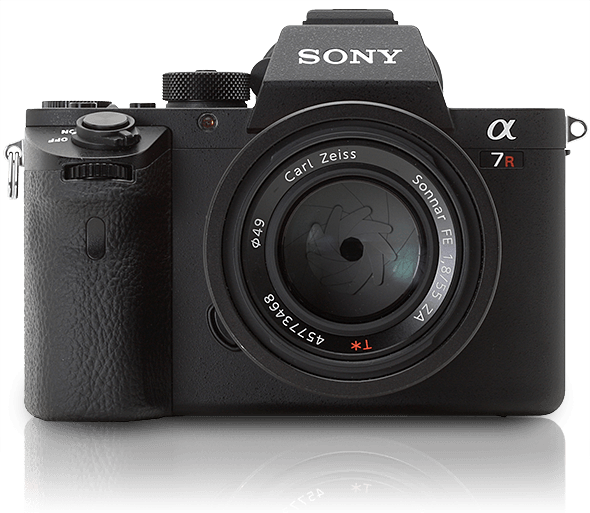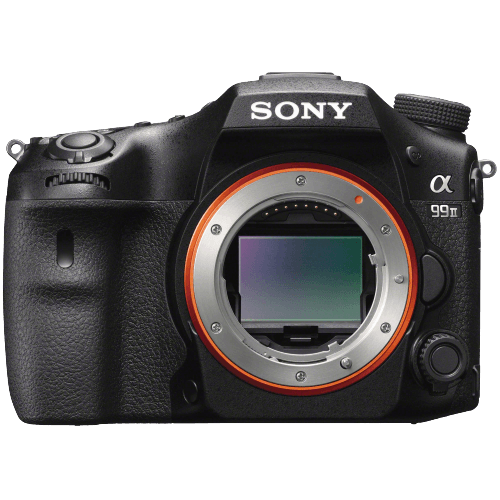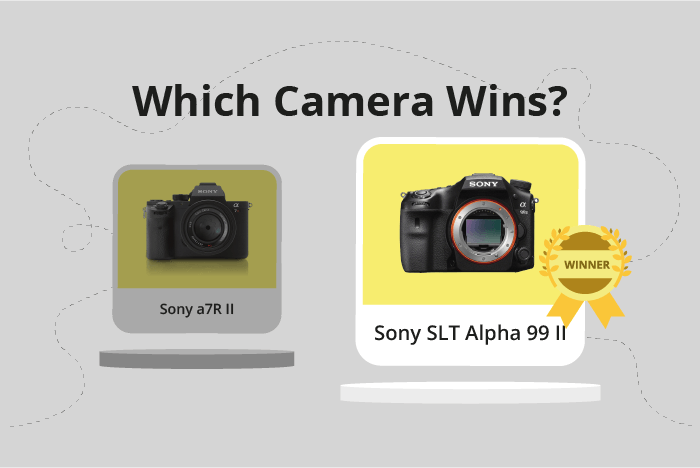Sony a7R II vs SLT Alpha 99 II Comparison
Sony a7R II

Sony SLT Alpha 99 II

The Sony SLT Alpha 99 II comes out on top with a score of 77/100, compared to the Sony a7R II, which scores 70/100. Both cameras share similarities such as their announcement year – 2015 for the a7R II and 2016 for the Alpha 99 II – and similar launch prices of $3198 and $3200, respectively.
The winning Alpha 99 II has a larger size (143 x 104 x 76mm) and a heavier weight (849g) than the a7R II (127 x 96 x 60mm, 625g). However, the a7R II has the advantage of being a mirrorless camera, which makes it more compact and portable.
Considering these factors, the Alpha 99 II offers superior performance, while the a7R II provides the benefit of easier portability. Each camera brings its strengths to the table, making the choice dependent on individual preferences and needs.
Sony a7R II vs SLT Alpha 99 II Overview and Optics
The Sony SLT Alpha 99 II wins in the optics comparison with a score of 82/100, while the Sony a7R II scores 81/100. Both cameras share several common specifications, including 42.4 megapixels, CMOS sensor type, Bionz X processor, full-frame sensor size, and image stabilization. These similarities contribute to the overall quality and performance of both cameras.
The winning camera, the Sony SLT Alpha 99 II, has a faster shooting speed of 12 frames per second, compared to the Sony a7R II’s 5 frames per second. This advantage allows the Alpha 99 II to capture fast-moving subjects and action scenes more effectively. Additionally, the Alpha 99 II uses the Sony Alpha lens mount, offering compatibility with a wide range of lenses.
On the other hand, the Sony a7R II has a higher DXOMARK score for its sensor, with a rating of 98 compared to the Alpha 99 II’s 92. This means the a7R II’s sensor performs better in terms of image quality, dynamic range, and low-light performance. The a7R II also features the Sony FE lens mount, providing access to a different selection of lenses.
Both cameras have their strengths and weaknesses. The Sony SLT Alpha 99 II is better for capturing fast action due to its higher shooting speed and benefits from a wider range of compatible lenses with the Sony Alpha mount. Conversely, the Sony a7R II has a superior sensor performance, making it more suitable for photographers prioritizing image quality and low-light capabilities. Ultimately, the choice between these two cameras depends on the specific needs and preferences of the photographer.
Sony a7R II vs SLT Alpha 99 II Video Performance
The Sony SLT Alpha 99 II outperforms the Sony a7R II in video capabilities with a score of 77/100, compared to the a7R II’s score of 56/100. Both cameras share some common specifications, such as 4K max video resolution and 3840 x 2160 max video dimensions. However, there are key differences that contribute to the Alpha 99 II’s superior video performance.
The most notable advantage of the Alpha 99 II is its max video frame rate of 120fps, while the a7R II only offers 30fps. This allows the Alpha 99 II to capture smoother, more detailed slow-motion footage, making it a better choice for videographers who require high-quality slow-motion capabilities.
On the other hand, both cameras lack built-in time-lapse functionality. This means that users seeking to create time-lapse videos will need to resort to external software or devices to achieve this effect, regardless of which camera they choose.
In terms of video performance, the Sony SLT Alpha 99 II clearly surpasses the Sony a7R II, mainly due to its higher max video frame rate. The Alpha 99 II caters to videographers who demand advanced slow-motion capabilities, while the a7R II falls short in this aspect. Despite both cameras lacking built-in time-lapse functionality, the overall video performance of the Alpha 99 II makes it a more suitable choice for videography purposes.
Sony a7R II vs SLT Alpha 99 II Features and Benefits
The Sony SLT Alpha 99 II outperforms the Sony a7R II in terms of features, scoring 70 out of 100, while the Sony a7R II scores 57. Both cameras share several specifications: they have 3-inch screens with a resolution of 1228800 dots, flip screens, and no touchscreens or GPS.
The Sony SLT Alpha 99 II has a clear advantage in connectivity, as it features Bluetooth, which the Sony a7R II lacks. This allows for easy transfer of images and remote control of the camera via compatible devices. The Sony a7R II, on the other hand, offers Wi-Fi connectivity, while the Alpha 99 II does not. Wi-Fi enables users to transfer images wirelessly and use their smartphones as remote controls.
Despite the higher feature score of the Sony SLT Alpha 99 II, the Sony a7R II has its own strengths. The presence of Wi-Fi connectivity makes it more versatile for photographers who need to share their images quickly or control their camera remotely. However, the lack of Bluetooth may be a drawback for some users who prefer that method of connectivity.
To conclude, the Sony SLT Alpha 99 II has a higher feature score due to its Bluetooth capabilities, making it better for users who prioritize that form of connectivity. The Sony a7R II, with its Wi-Fi connectivity, is more suitable for those who value wireless image transfer and remote control through their smartphones. Both cameras have their own advantages and are tailored to different user preferences.
Sony a7R II vs SLT Alpha 99 II Storage and Battery
The Sony SLT Alpha 99 II outperforms the Sony a7R II in storage and battery with a score of 60/100 compared to 16/100. Both cameras share compatibility with SD, SDHC, and SDXC memory cards, and neither offers USB charging. However, the Alpha 99 II has two memory card slots compared to the a7R II’s single slot, providing more storage flexibility.
The Alpha 99 II also boasts a longer battery life at 490 shots, while the a7R II manages only 290 shots. This difference enhances the Alpha 99 II’s usability as it requires less frequent battery changes. The a7R II does not offer any advantages in storage and battery over the Alpha 99 II.
Given these points, the Sony SLT Alpha 99 II proves to be superior in storage and battery performance, making it a more practical choice for photographers who require extended shooting sessions and storage options.
Alternatives to the Sony a7R II and SLT Alpha 99 II
Are you still undecided about which camera is right for you? Have a look at these popular comparisons that feature the Sony a7R II or the Sony SLT Alpha 99 II:

